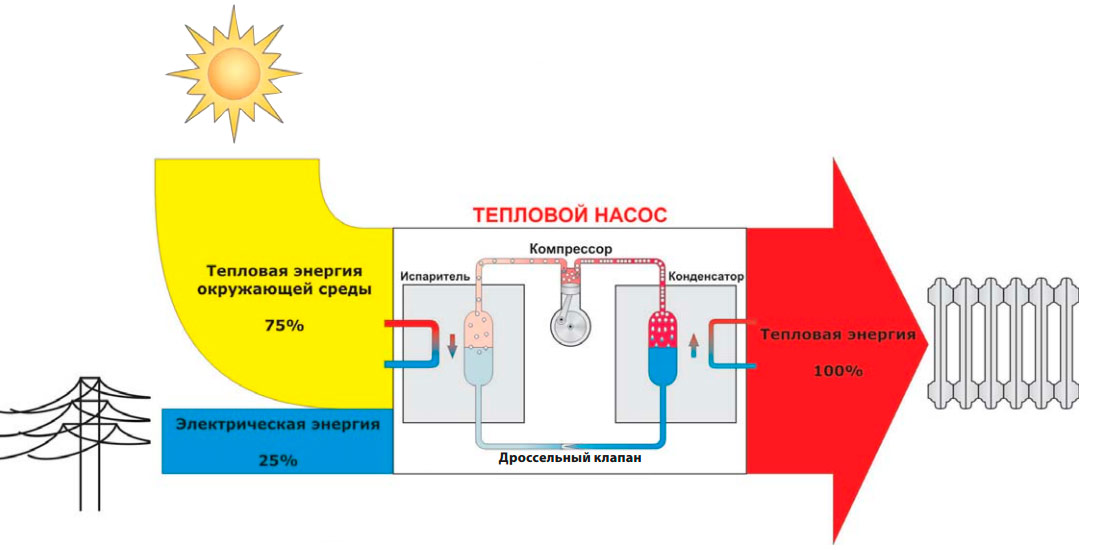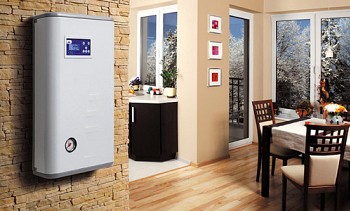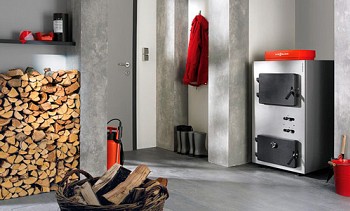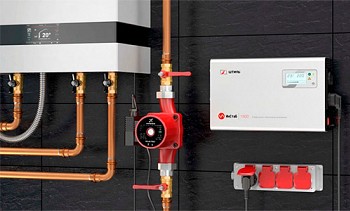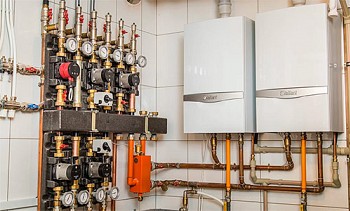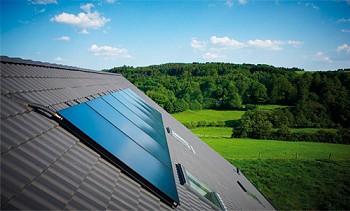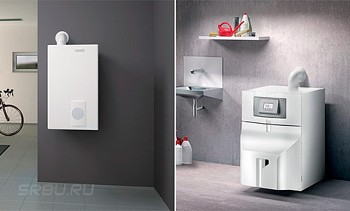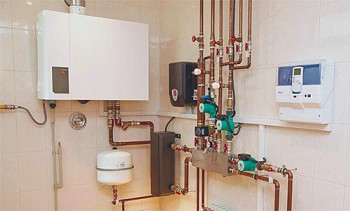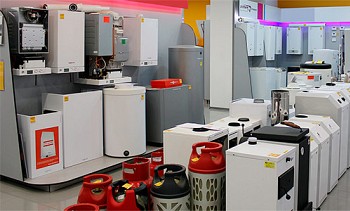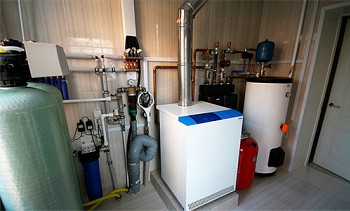Heat pump for heating a house: principle of operation, varieties and use
In the face of deteriorating environmental conditions in the world and (more important for the average consumer) a rapid increase in gas and electricity tariffs, more and more Europeans are trying to introduce alternative energy sources into their daily lives. One of the options for such systems is the so-called heat pump, through which you can heat your home in the winter and heat water for domestic purposes, spending a minimum of electricity on it.
In the homes of our compatriots in recent years, too, you can increasingly meet this miracle of engineering. Of course, for Russians, the problem of high prices for traditional energy sources is not so acute as in Europe, but, firstly, it is only for the time being, and secondly, I do not want to lag behind the civilized world ...
So, the heat pump ... What is it? What is the principle of its action based on? Where, where and how does he pump heat? Let's get it right.
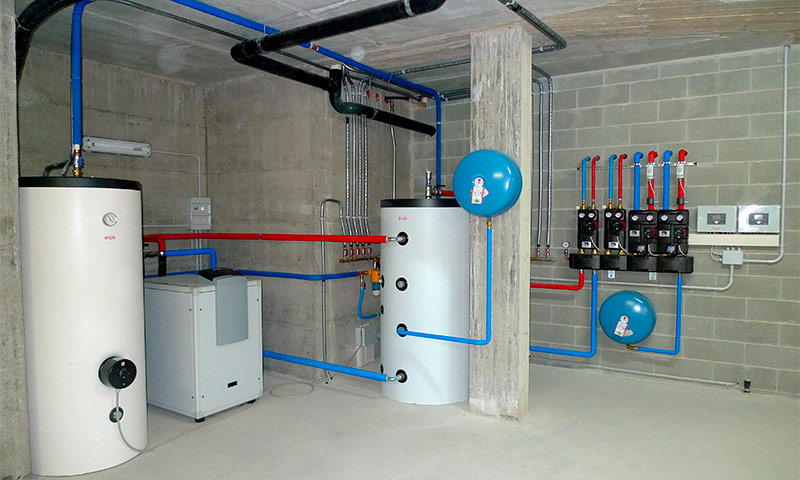
Content:
The principle of operation of the heat pump
The principle of operation of heat pumps is based on the ability of a substance (refrigerant) to absorb or give off heat when the state of aggregation changes. In essence, such pumps are not much different from refrigeration units. (This strange, at first glance, statement will not surprise you at all if you have ever touched the hot back wall of an ordinary household refrigerator.)
Schematically, a heat pump can be represented as a system consisting of three circuits. The first is a coolant that transfers energy from a source of low potential heat. In the second circuit, refrigerant (freon) circulates, which periodically evaporates, taking heat from the first circuit, then condenses again, giving it to the third circuit. And, finally, the heat sink “runs” along the third circuit, in our case, water that transfers heat through the heating system.
The duty cycle of the heat pump in general terms can be described as follows. Liquid refrigerant enters the evaporator, where it passes into a gaseous state. The energy necessary for this process to flow is taken from the coolant circulating in the primary circuit. Then, gaseous refrigerant preheated by several degrees is sucked into the compressor, the main purpose of which is gas compression (of course, this consumes electricity).
The gas pressure increases several times, while it warms up significantly: if the refrigerant temperature at the inlet to the compressor is 6-10 ° C, then at the outlet it is already about 60 ° C. At the next stage, the heated gas is sent to the condenser, where it gives off the received heat to the heating system, while it condenses itself, i.e. goes into a liquid state. Then the overpressure is relieved by means of a throttle valve, and the cycle starts again.
As you can see, the device of the heat pump does not differ fundamentally from the device of the refrigeration machine. It's just that the main purpose of refrigeration units is to generate cold, so there the heat is taken out by the evaporator, and the condenser only dumps this heat into the surrounding space.In the heat pump, the opposite is true: the condenser is a heat exchanger that gives heat to the consumer, and the evaporator is a heat exchanger that utilizes the low-potential heat of secondary energy resources.
In other words, a heat pump is a “refrigerator the other way around." At the same time, "vice versa" is not only a device, but also a result. If in the case of a refrigerator, the heat taken from the products stored inside is wasted, then the energy generated by the heat pump brings real benefits - it is spent on targeted heating of the house.
Varieties of heat pumps and systems
The heat energy spent on heating the building and the hot water system is the result of the conversion of environmental energy by using a heat pump. The pump concentrates this low-potential (low-temperature) energy and transfers it to the heating system.
It remains to understand what is meant in this case by the energy of the environment. Most domestic heat pumps allow you to use the heat of the sun and the internal heat of the earth, accumulated by the upper layers of the earth's crust and water throughout the year.
By the type of design of the first circuit of the heat exchanger, all heat pumps are divided into soil, water and air.
Ground Heat Pumps
Ground heat pumps receive the heat necessary to heat the refrigerant in the evaporator from the ground. The temperature of the latter at a depth of several meters is practically not subject to seasonal fluctuations. In a closed system of pipes placed in the ground, a "brine" circulates. It is not by chance that we quoted the word “pickle” in quotation marks: salt, as one might expect from the name, does not contain it. In fact, it is an antifreeze based on ethylene glycol or propylene glycol, less often aqueous ethanol. Heat exchanger pipes can be laid in the ground both horizontally (horizontal collector) and vertically (geothermal probe).
Horizontal collector pipes are laid in the ground at a depth below the level of soil freezing in this region (usually 1.5-2 m). The heat exchange system of this type occupies a fairly large area. For example, to provide heat to a relatively small house with an area of 100 m2 it will be necessary to allocate 2-3 acres of land. It should be taken into account that on the territory occupied by the collector, only those trees and shrubs can be planted whose roots do not go too deep into the soil, and it is completely impossible to place any buildings here.
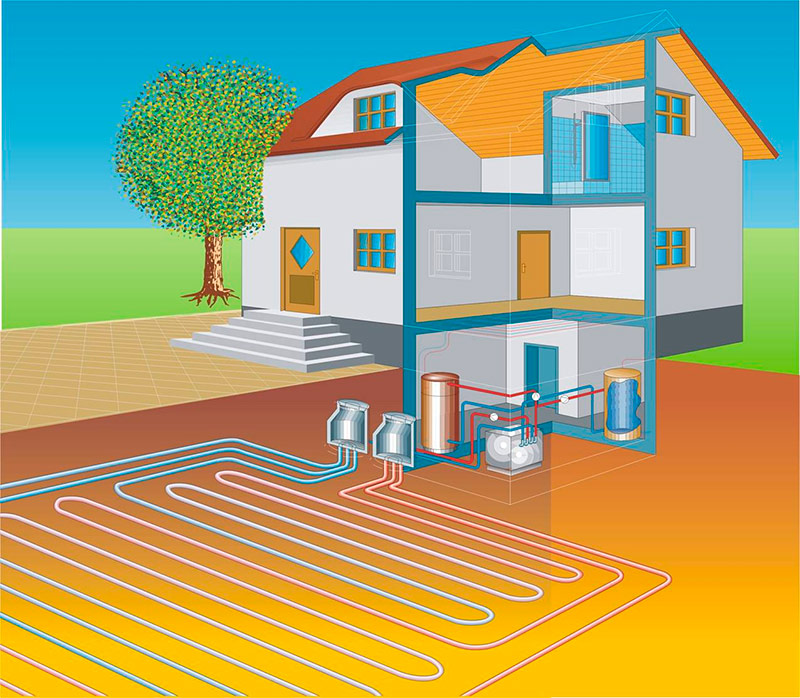
A geothermal probe is a heat exchanger whose pipes are placed vertically and immersed in soil to a depth of 100-200 m. The number of probes installed depends on the required capacity of the installation. To heat the house, which we have already considered above as an example, two probes with a length of about 80 m located at a distance of 5 m from each other will suffice.
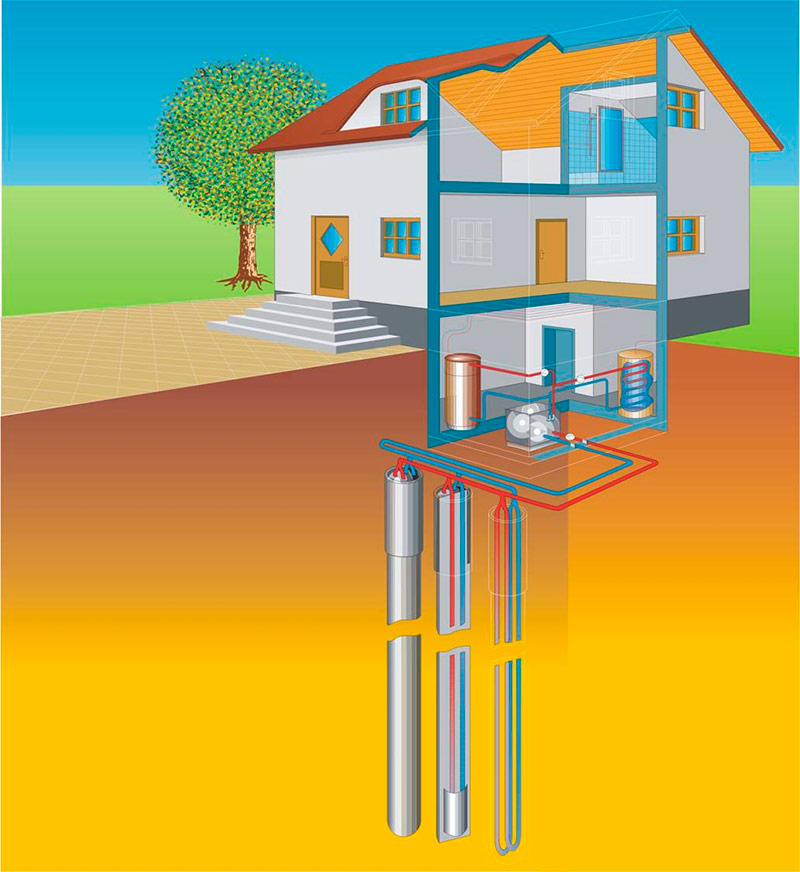
As you can see, this system does not require large areas, you can drill wells in any part of your site - wherever it is convenient for you. The main disadvantage of soil heat pumps with geothermal probes is the high cost of well drilling. However, despite this, most users give preference to precisely these systems, because geothermal probes are more efficient than horizontal collectors, and have fewer restrictions.
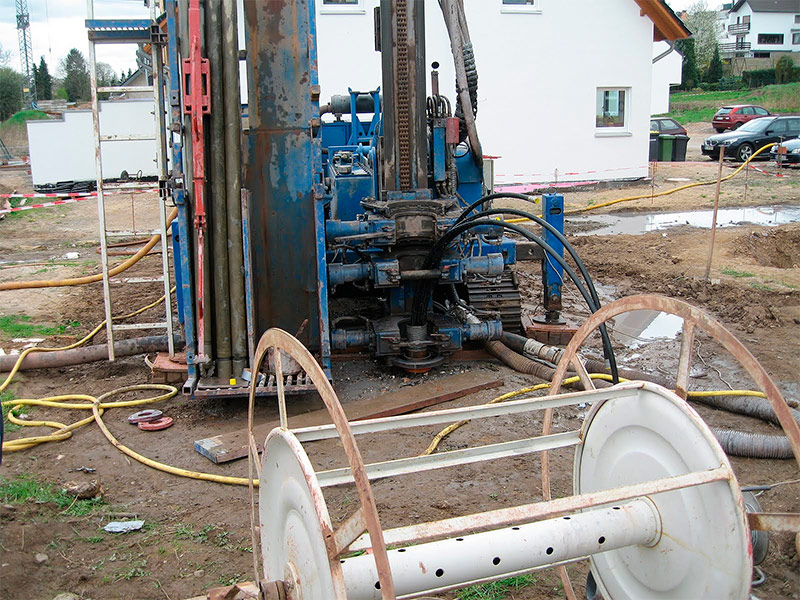
Drilling a well for a geothermal probe.
Water heat pumps
The water heat pump “draws” the energy of groundwater, which it pumps through its evaporator. Such a system is characterized by increased efficiency and good stability: the first characteristic is the result of high heat transfer of water, the second is due to the constancy of the temperature of groundwater.
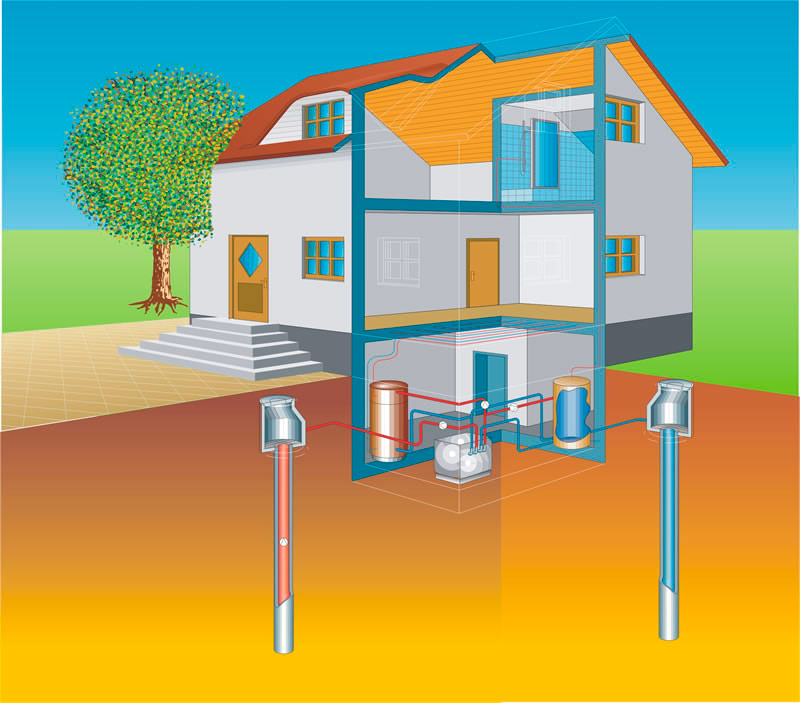
Of course, in order to use this type of installation, it is required that these same ground waters be available in your territory, and in a sufficiently large amount.It is highly desirable that the aquifer is located no deeper than 30-40 m. The simultaneous fulfillment of these two conditions is an infrequent phenomenon. Another condition, the failure of which may become an obstacle to the installation of a water heat pump in your house or cottage, is a low content of iron salts and other impurities in groundwater.
Using low quality water will cause the equipment to quickly fail, as the heat exchanger simply clogs. The presence of so many restrictions is the reason that such heat pumps, despite their attractiveness, are installed infrequently (about 5% of all implemented projects).
Air heat pumps
In terms of ease of installation, air heat pumps have a huge advantage over their "brothers". To use ambient air as a source of heat, you do not have to drill wells or carry out any other large-scale soil work. As a result, if you put in the estimate the cost of installing equipment, an air pump will cost you much less than a water or ground pump.
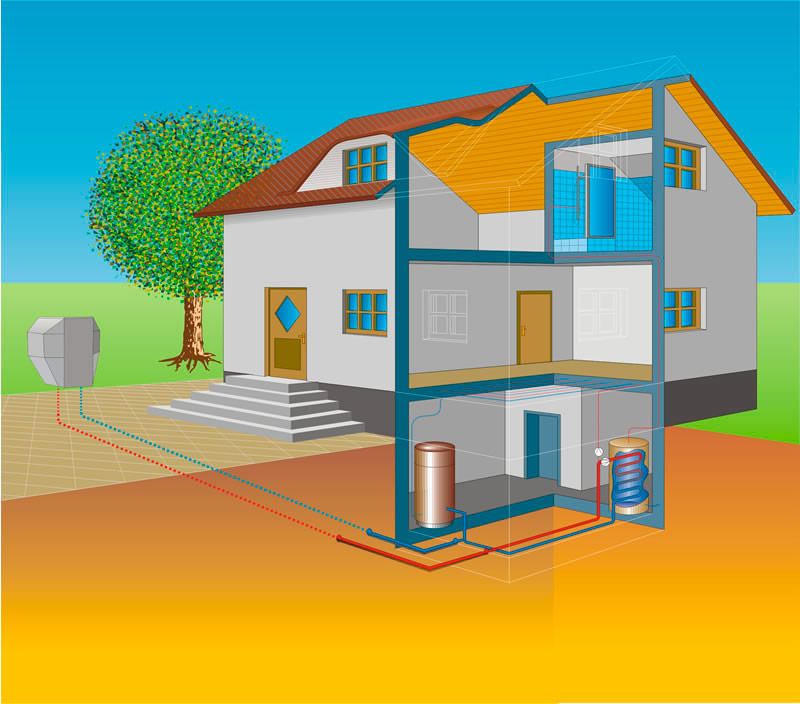
Despite such a significant advantage, this type of climatic equipment cannot be called ideal, since it also has a significant drawback. Such a pump only works efficiently when the ambient temperature is above –15 ° C ... –20 ° C. A drop in temperature below this border, which in winter is not uncommon in most regions of our country, leads to a significant decrease in the efficiency coefficient of an air heat pump.
Heat Pump Efficiency Ratio
A little higher, we used the new term - “efficiency coefficient”. It would be wrong not to explain what it is, especially since it is an important characteristic of heat pumps that allows you to compare different types of pumps with each other.
The efficiency coefficient (also called the transformation coefficient) is the ratio of the thermal energy generated by the pump to the electrical energy consumed by it. In fact, this is the efficiency of the heat pump. In the case of water heat pumps, this coefficient is 5, regardless of the time of year. This means that when 1 kW * h of electricity is consumed, the installation produces 5 kW * h of thermal energy.
In soil pumps, the value of the efficiency coefficient is slightly lower - from 4 to 4.5. And, finally, the air heat pumps are characterized by the smallest coefficient, and their efficiency strongly depends on the ambient temperature: at 0 ° C the coefficient is ~ 3.5, and at –20 ° C it does not exceed 1.5 (at such a low efficiency, the pump it just doesn’t pay off, and it makes sense to think about purchasing cheaper climate equipment, such as an electric boiler).
Some managers, advertising the heat pumps they sell, assure potential customers that this equipment has an efficiency of 400-500%. Of course, there is no talk of any violation of the laws of thermodynamics. It’s just that in this case, the calculations are intentionally done wrong: energy sources other than the consumed electricity are not taken into account - air, water or soil, heated by the Sun and geothermal processes. When when calculating the efficiency, only electricity is taken into account and they forget about the source of low-grade heat, the result is more than 100%.
The use of heat pumps in the Russian climate
Having become acquainted with the above descriptions of the various types of heat pumps, you can easily answer the question yourself, which pump is most suitable for operation in the Russian climate.
Air heat pumps are suitable for use only in a limited number of regions of our country - where the air temperature in winter almost does not drop below zero. Of course, residents of Siberia, the Far East, the north of the European part of Russia should not even think about air heat pumps.
There are many limitations to the use of water heat pumps. We have already talked about some of them; it remains to mention one more. More than half of the territory of our country is in the permafrost zone. If even some resident of Eastern Siberia or the north of the Far East is “lucky” and there is groundwater in its section that does not lie too deep, then still these groundwater is in the form of ice, which means that it is not suitable for use in the heating system .
Thus, most of our compatriots have to rely on the only, win-win, option - a ground heat pump. Moreover, in conditions of the Russian climate, a pump with a horizontal collector rather than with a horizontal probe, which allows reaching a depth where the soil temperature is more stable, is more suitable.
Heat pump application for cooling
A huge advantage of heat pumps is that they can not only heat the house, but also, if necessary, cool it. Our short Russian summer is sometimes very hot, and when your home literally becomes hot, the proposal to turn the heater into an air conditioner will be very useful.
A technical solution to this issue can be integrated into the heat pump initially, at the manufacturing stage, and almost all manufacturers have a line of pumps that can condition the room (Natural Cooling mode). If your heat pump does not have such abilities, everything is still not lost - a regular pump can also work for cooling. The necessary additional equipment in the form of hydraulic decoupling will be mounted outside the pump. Both options do not require large investments.
You can carry the cold generated by the heat pump directly into the room in various ways. This function can be assigned to cold panels on walls or ceilings, cooling underfloor heating, radiators with good airflow, or a fan coil - a device in which a plate heat exchanger blown by a fan is built-in.
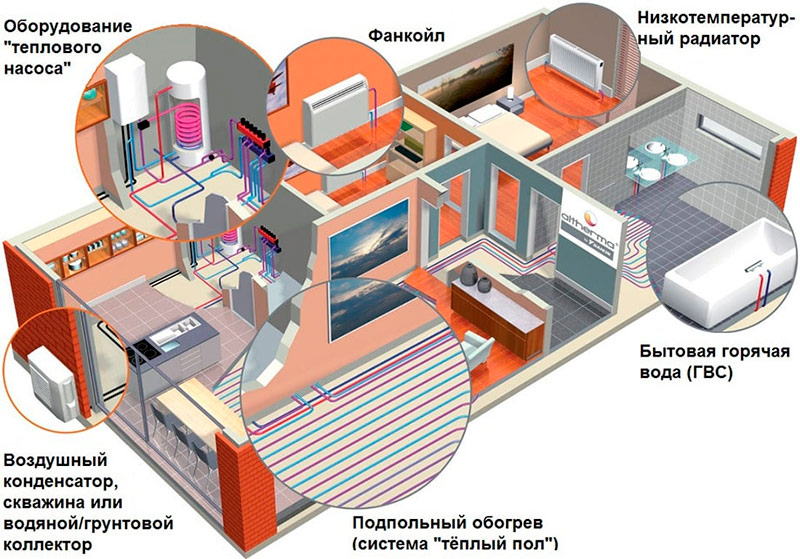
The use of a heat pump for hot water
Any heat pump can not only heat your home, but also supply you with hot water year-round. However, it should be borne in mind that this system is low temperature, which means that the water temperature in the boiler will not exceed 45-55 ° C. It follows that the volume of the boiler should be greater than when using a standard heating system, otherwise you and your household will have to live in conditions of austerity of hot water.
This fact should be taken into account when allocating space for a boiler room, i.e., even at the stage of designing a house. Also, when choosing a boiler, you need to take into account that this should be special equipment designed to work with heat pump installations. The main difference between this boiler and the usual one is the increased area of the heat exchanger necessary for the most efficient heat transfer from the heat pump.
Heat pumps with integrated heating element
Often manufacturers integrate additional electric heaters into their heat pumps. The built-in heater allows, if necessary, to switch to an alternative source of energy from the point of view of the heat pump - electricity. What is it for? In what cases there is a need to use the heater?
The selection of a heat pump for heating a house is carried out taking into account various parameters, including the climatic features of the region. It is considered inappropriate to install a pump with excess power. The fact is that extremely cold days do not happen very often, at least in the central European part of Russia. Practice shows that a more economical option is to "get" the necessary power with electricity during these frosty periods than to initially install a more powerful pump. The presence of a heating element eliminates the need to make the system more powerful than is required for most of the heating season.
For owners of water and ground heat pumps, an integrated heater is more of an excess than a necessity. The situation with air heat pumps looks completely different. At an air temperature of –20 ° C or lower, such a pump, if it does not turn off, will be ineffective. And although there are not so many cold days and nights in the year, I do not want to stay in a rapidly freezing house at one fine moment. The presence of a duplicate heat generator in this case can not be called a luxury.
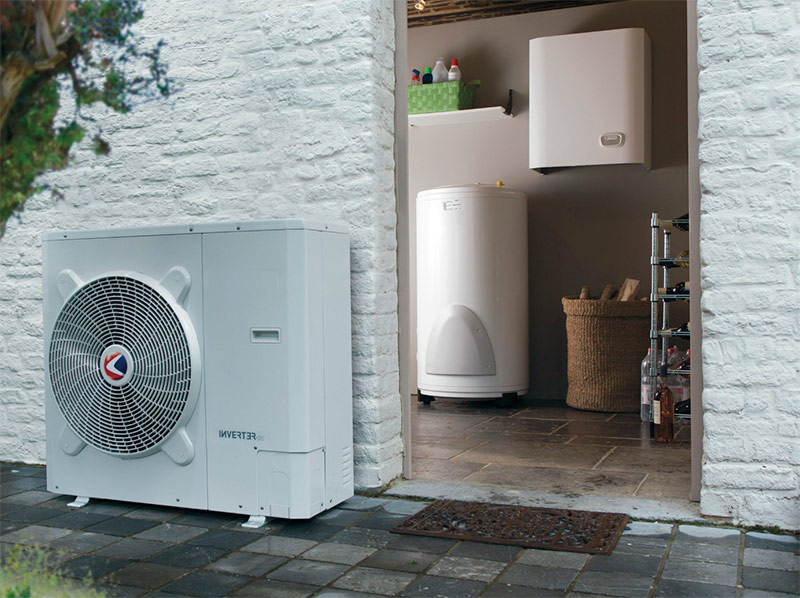
Air heat pump.
Tips & Tricks
A heat pump is a technically sophisticated and quite expensive equipment, so you should approach its selection with great responsibility. In order not to be unfounded, we give some very specific recommendations.
1. Never start choosing a heat pump without first making calculations and creating a project. The lack of a project can cause fatal errors, which can only be corrected with the help of huge additional financial investments.
2. Only professionals should entrust the design, installation and maintenance of the heat pump and heating system. How to make sure that professionals work in this company? First of all, according to the availability of all necessary documentation, a portfolio of sold objects, certificates from equipment suppliers. It is highly desirable that the whole range of necessary services is provided by one company, which in this case will be fully responsible for the implementation of the project.
3. We advise you to give preference to the European-made heat pump. Do not be confused by the fact that it is more expensive than Chinese or Russian equipment. When the cost of installation, commissioning and debugging of the entire heating system is included in the estimate, the difference in the price of the pumps will be almost imperceptible. But then, having a “European” at your disposal, you will be sure of its reliability, since the high price of the pump is only the result of using modern technologies and high-quality materials in its creation.

